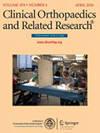Is Displacement of the Lesser Trochanter Associated With Functional Outcome in Older Adults With Intertrochanteric Fractures?
IF 4.4
2区 医学
Q1 ORTHOPEDICS
引用次数: 0
Abstract
BACKGROUND Lesser trochanter displacement in intertrochanteric fractures has been linked to fracture instability and altered hip biomechanics, with evidence suggesting that proximal or medial displacement of the fragment by ≥ 10 mm may lead to poorer clinical outcomes. However, whether such displacement is associated with multidomain functional outcomes and patient performance remains unclear. QUESTIONS/PURPOSES In older adults with intertrochanteric fractures treated with internal fixation using a cephalomedullary nail, we asked: (1) Were functional outcome measures, including the Harris hip score (HHS), de Morton Mobility Index (DEMMI), and the Barthel Index, negatively associated with lesser trochanter displacement of ≥ 10 mm? (2) Was lesser trochanter displacement of ≥ 10 mm associated with a decreased ability to complete tasks during performance assessments and inferior performance scores on the Functional Reach Test (FRT), Timed Up and Go test (TUG), and 5 Times Sit-to-Stand (5TSTS) test? METHODS Between January 2021 and October 2023, four fellowship-trained orthopaedic surgeons at a Level I trauma center treated older adults with intertrochanteric hip fractures. Short cephalomedullary nails were used in approximately 90% of patients, typically for displaced fractures, including both stable and unstable types. Of the 123 patients treated with a cephalomedullary nail, 7% (9) were lost to follow-up before 1 year, 9% (11) died within 1 year, and 12% (15) were excluded based on predefined criteria, leaving 72% (88) of patients for analysis in this retrospective comparative study. There was no evidence of differential loss to follow-up or mortality between the displacement groups. Patients were divided into two groups based on postoperative lesser trochanter displacement: patients with < 10 mm of proximal or medial displacement, including an intact lesser trochanter (n = 44), and patients with displacement of ≥ 10 mm (n = 44). Baseline characteristics, including demographics, American Society of Anesthesiologists classification, and preinjury Barthel Index, did not differ between the groups. Functional outcomes, including the HHS, the DEMMI (which assesses mobility across a range of physical tasks), and the Barthel Index (which measures independence in activities of daily living) were assessed at 3 months and 1 year postoperatively. All three scores range from 0 to 100, with higher scores indicating better function. These capture different domains of recovery, allowing for a more comprehensive evaluation of patient outcomes. Performance tests (FRT, TUG, 5TSTS) were assessed at the same time points by experienced orthopaedic surgeons, and the groups were compared on those endpoints. The minimum clinically important difference (MCID) or minimal detectable change at 95% confidence (MDC95) values were: HHS (MCID = 16 to 18), DEMMI (MCID = 10), Barthel Index (MCID = 8.4), FRT (MDC95 = 6.4 to 8.2 cm), TUG (MCID = 2.9 to 4.9 seconds), and 5TSTS (MCID = 3.6 seconds). RESULTS We found no clinically important difference in HHS at either 3 months or 1 year. Patients whose fractures had < 10 mm of displacement showed higher DEMMI scores at 3 months (50 ± 15 versus 37 ± 13, mean difference 13 [95% confidence interval (CI) 7 to 19]; p < 0.001) and a borderline meaningful difference at 1 year (52 ± 17 versus 42 ± 15, mean difference 10 [95% CI 3 to 16]; p = 0.01). Barthel Index scores were also higher at 3 months (85 ± 14 versus 68 ± 20, mean difference 17 [95% CI 9 to 24]; p < 0.001) but not at 1 year. Patients with lesser trochanter displacement of < 10 mm also demonstrated better performance in the TUG test at both 3 months (48 ± 31 versus 68 ± 31 seconds, mean difference -20 [95% CI -34 to -5]; p = 0.01) and 1 year (37 ± 27 versus 52 ± 32 seconds, mean difference -15 [-29 to -1]; p = 0.03). No meaningful differences were observed in the FRT or the 5TSTS test at either time point. A higher percentage of patients with < 10 mm of displacement completed the tests (93% [41 of 44] versus 73% [32 of 44]; p < 0.001). CONCLUSION Intertrochanteric fractures with ≥ 10 mm of lesser trochanter displacement were associated with some poorer short-term functional and patient performance outcomes compared with patients with less displacement, although these differences diminished over time. The possible clinical benefit of surgically addressing the displaced fragment should be carefully weighed against the risks associated with a more extensive procedure. Further studies are warranted to address this issue. LEVEL OF EVIDENCE Level III, therapeutic study.老年粗隆间骨折患者小转子移位与功能预后相关吗?
背景:股骨粗隆间骨折的小转子移位与骨折不稳定和髋关节生物力学改变有关,有证据表明近端或内侧碎片移位≥10mm可能导致较差的临床结果。然而,这种移位是否与多域功能结局和患者表现有关尚不清楚。问题/目的:在采用头髓内钉内固定治疗的老年粗隆间骨折患者中,我们的问题是:(1)包括Harris髋关节评分(HHS)、de Morton活动指数(DEMMI)和Barthel指数在内的功能指标是否与小粗隆位移≥10 mm负相关?(2)小转子移位≥10mm是否与性能评估中完成任务的能力下降和功能伸展测试(FRT)、计时起身测试(TUG)和5次坐立测试(5TSTS)得分较低有关?方法:在2021年1月至2023年10月期间,四名在一级创伤中心接受过奖学金培训的骨科医生治疗了老年股骨粗隆间髋部骨折。大约90%的患者使用短头髓内钉,通常用于移位性骨折,包括稳定型和不稳定型。在123例接受颅髓钉治疗的患者中,7%(9)例患者在1年内失访,9%(11)例患者在1年内死亡,12%(15)例患者根据预先设定的标准被排除,剩下72%(88)例患者在本回顾性比较研究中进行分析。没有证据表明流离失所组之间的随访损失或死亡率存在差异。根据术后小转子移位情况将患者分为两组:近端或内侧移位< 10mm(包括完整的小转子)的患者(n = 44)和移位≥10mm的患者(n = 44)。基线特征,包括人口统计学、美国麻醉医师学会分类和损伤前Barthel指数,在两组之间没有差异。功能结果,包括HHS, DEMMI(评估一系列体力活动的灵活性)和Barthel指数(衡量日常生活活动的独立性)在术后3个月和1年进行评估。这三个分数的范围从0到100,分数越高表明功能越好。这些涵盖了不同的康复领域,允许对患者结果进行更全面的评估。由经验丰富的骨科医生在同一时间点对性能测试(FRT, TUG, 5TSTS)进行评估,并根据这些终点对两组进行比较。最小临床重要差异(MCID)或95%置信度(MDC95)值的最小可检测变化为:HHS (MCID = 16至18),DEMMI (MCID = 10), Barthel指数(MCID = 8.4), FRT (MDC95 = 6.4至8.2 cm), TUG (MCID = 2.9至4.9秒)和5TSTS (MCID = 3.6秒)。结果我们发现HHS在3个月和1年没有显著的临床差异。骨折移位< 10 mm的患者在3个月时DEMMI评分较高(50±15比37±13,平均差13[95%可信区间(CI) 7 ~ 19];p < 0.001)和1年的临界有意义差异(52±17 vs 42±15,平均差异10 [95% CI 3 ~ 16];P = 0.01)。3个月时Barthel指数评分也较高(85±14比68±20,平均差17 [95% CI 9 ~ 24];P < 0.001),但在1年内没有。小转子位移< 10 mm的患者在3个月的TUG测试中也表现出更好的表现(48±31比68±31秒,平均差异为-20 [95% CI -34至-5];P = 0.01)和1年(37±27比52±32秒,平均差-15[-29比-1];P = 0.03)。在任何一个时间点,FRT或5TSTS测试均无显著差异。位移< 10 mm的患者完成测试的比例更高(93%[41 / 44]对73% [32 / 44];P < 0.001)。结论:与移位较小的患者相比,小转子移位≥10mm的股骨粗隆间骨折的短期功能和患者表现较差,尽管这些差异随着时间的推移而减弱。手术治疗移位碎片可能带来的临床益处应仔细权衡与更广泛手术相关的风险。需要进一步的研究来解决这个问题。证据等级:III级,治疗性研究。
本文章由计算机程序翻译,如有差异,请以英文原文为准。
求助全文
约1分钟内获得全文
求助全文
来源期刊
CiteScore
7.00
自引率
11.90%
发文量
722
审稿时长
2.5 months
期刊介绍:
Clinical Orthopaedics and Related Research® is a leading peer-reviewed journal devoted to the dissemination of new and important orthopaedic knowledge.
CORR® brings readers the latest clinical and basic research, along with columns, commentaries, and interviews with authors.

 求助内容:
求助内容: 应助结果提醒方式:
应助结果提醒方式:


